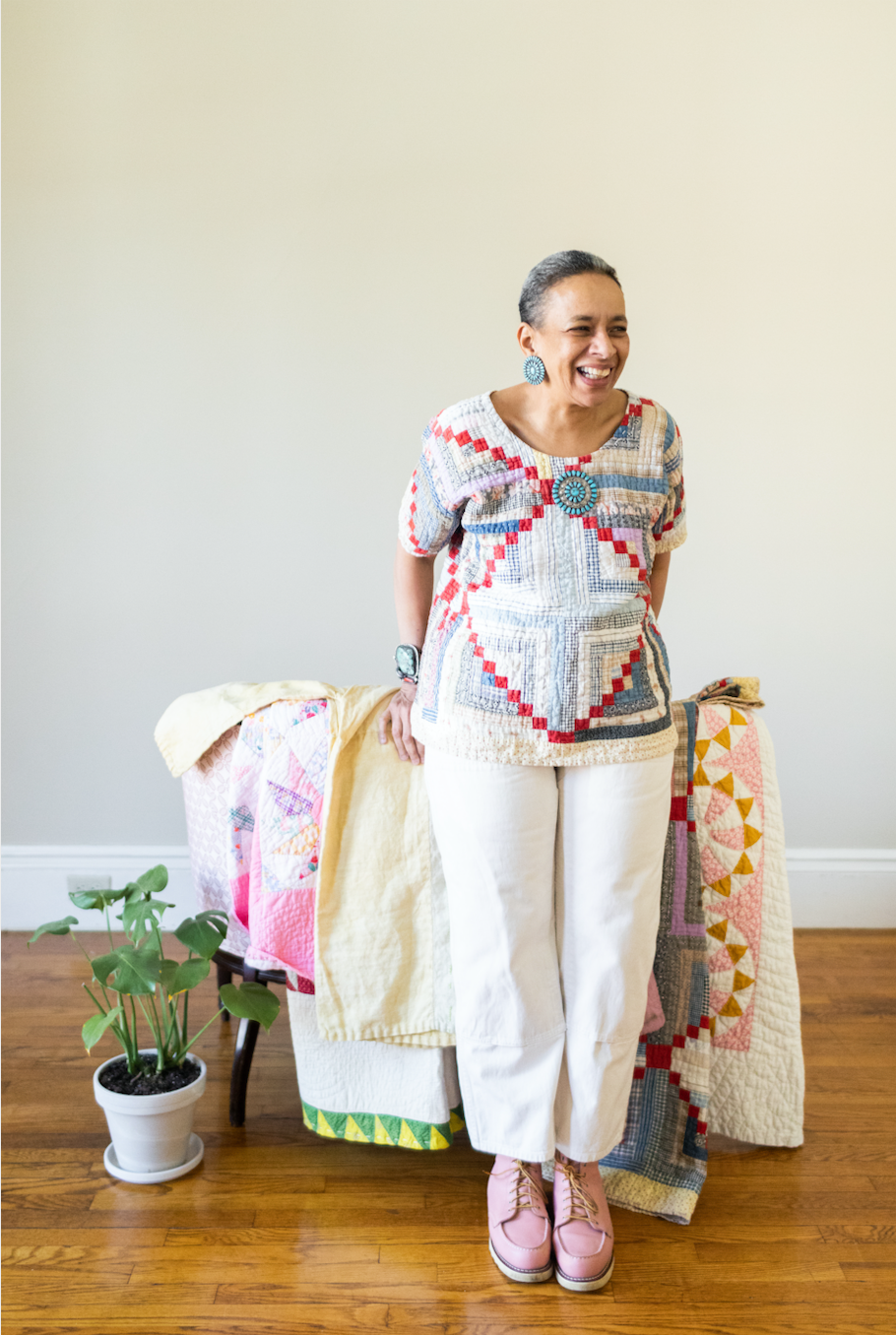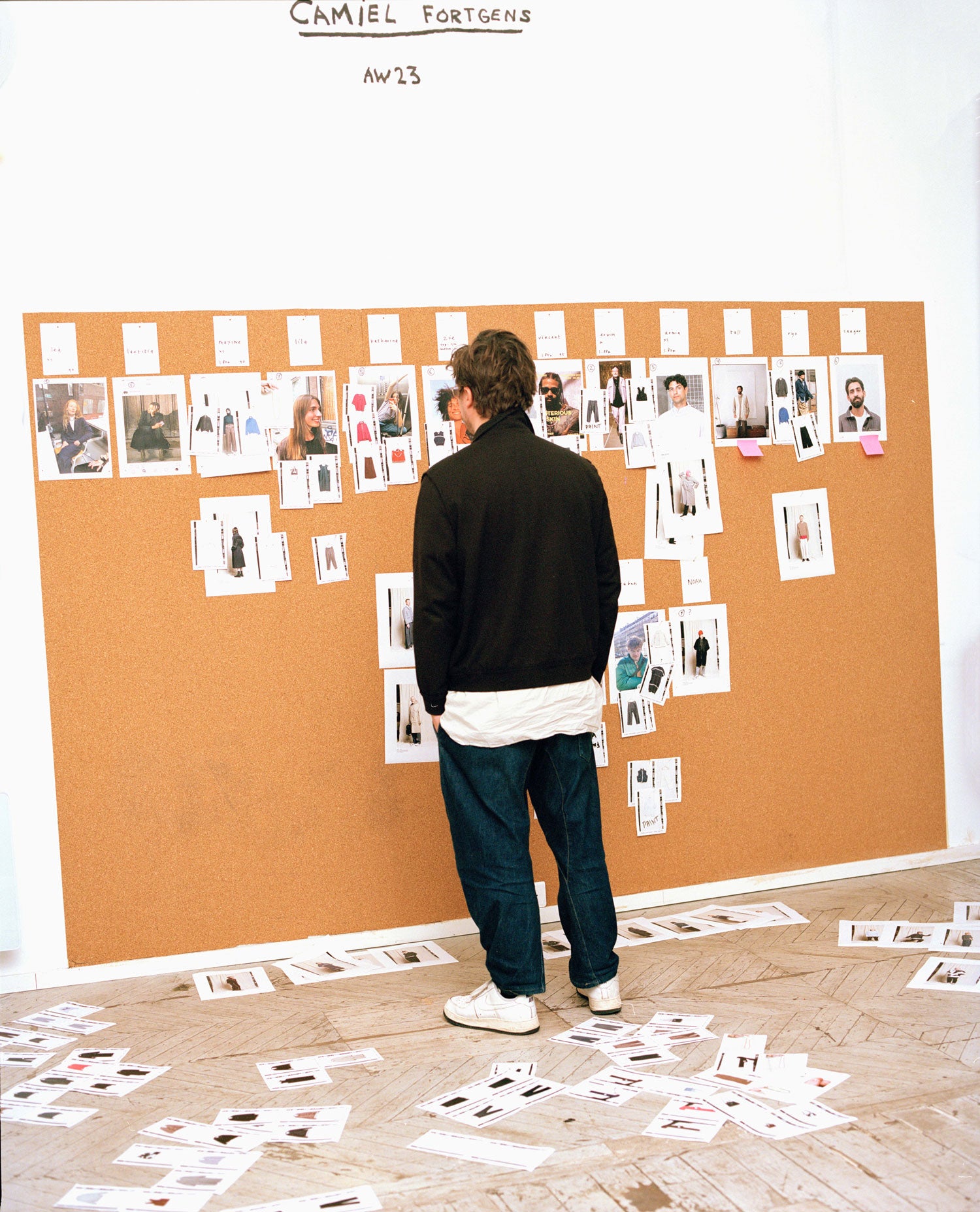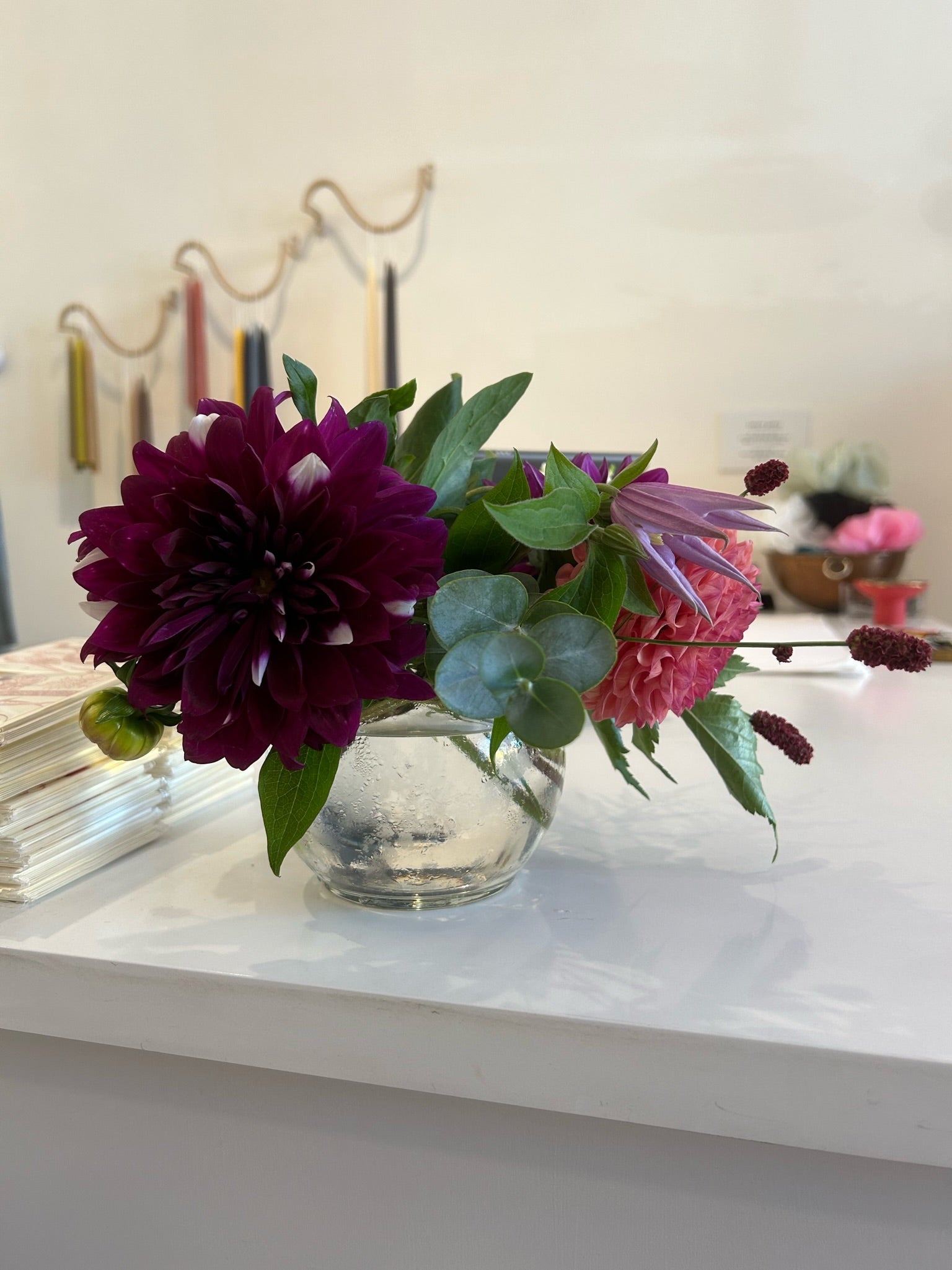Sharon Chandler Correnty of Marigold

Sitting at my laptop, I hear a chime and I’m greeted by Sharon as she enters the video meeting. She’s sitting in her Groton studio wearing pinstripe overalls. There’s a big brooch pinned onto the overalls. The wall behind her is covered in inspiration. I see scraps of fabric, a dress, and a photo of her daughters. Sharon Chandler Correnty is an interdisciplinary artist and maker living about an hour away from Covet + Lou in Mass. She is the woman behind the lovingly named, Marigold, a retail studio space at the Prescott Community Center in Groton. We met Sharon through her daughter, Wren, a slow fashion enthusiast (and friend of Covet + Lou) working in the art space.
Sharon is an Ichi Antiquités fan and she tells me that C+L is very much “her aesthetic.” We wanted to learn more about Marigold as it’s really exciting to see slow-fashion happening locally. We also like to highlight friends of the shop and Sharon has become just that! Here's our conversation.
Sharon, we’re so excited to introduce you and your retail studio space, Marigold, to our community. Can you tell us a little about yourself and how you started Marigold?
I grew up in Harvard, MA. My family on my mother’s side comes from pre-revolutionary war time in Harvard, so I really have rich roots embedded in this town. Back then, women sewed their own clothing. I grew up in a house where the sewing machine was a focal point. I grew up learning how to sew and make my own clothes. Not always so good. (She laughs). Growing up in that culture I was always drawn to textiles.
I went from art major to art educator. My studio was always jewelry, textiles, and weaving. I’m also a master felter. A lot of my art education and teaching incorporated a strong fiber component.
More on how Marigold started…
I wanted to design my perfect art teacher uniform. That was my big project. Not a typical artist smock. I came up with a design that was sort of part overalls and dress, denim. It was sort of overalls maneuvered into a dress. That’s when this spark took off. I thought, I really like making clothes again.
In my sixties I went to a camp called A Gathering of Stitches in midcoast Maine and confirmed that I don’t like rules and I don’t like restriction. I like cutting up fabric and assembling like a puzzle piece. In every single garment I’ve made and sold through Marigold, nothing has ever been through a pattern. I literally get a piece of fabric and just start cutting.
The natural dye process is done through my garden. I grow marigolds and indigo leaves. We (Sharon and her husband) cultivate the plants and put them through the oven, it’s like a dehydrator. I’m drawn to that marigold yellow. It makes people smile. That’s how the name happened.

Let’s talk more about your quilt dresses. Huge congratulations on your Vogue UK feature! You describe the dresses as wearable pieces of art and history. Perhaps you can tell us more about what drew you to this concept of giving something old a new life?
When my Great Aunt passed away, her family went in and did a blanket sweep throwing everything into the dumpster. I remember going into the dumpster and finding a quilt my Great Aunt had made. It was really distressed. But I looked at it as fabric. I cut it and stitched it up and I wore it. With the exposed distressed area showing. My criteria for cutting a quilt is that it has to be distressed, stained, flawed. I won’t cut up a quilt if it’s not flawed.
I would see quilts throughout my travels. I wore them and I loved wearing them. They were showstoppers. If people stop you more than 3 times it’s a show stopper in my book. I got a lot of positive feedback.
It was two years ago when my daughter Wren asked me to be a plus-one at an art opening. I bribed her: I will only go if you wear one of mom’s dresses I said. That’s the Chloë Sevigny story. Chloë walked across the gallery floor and talked to Wren. She said, I wanna know how I can get my hands on one of these dresses. This was on a Thursday night. Wren put my info into Chloe’s instagram. She was super smooth about it. Fast forward to Sunday, I’m sitting hand stitching, you know, making clothes and a message comes up from Chloë. She was going to be in P-town (Provincetown, MA) and she wanted to pick up a dress.
So I said to my husband, let’s take a ride to the Cape. I bought a basket of quilt dresses and a bottle of hard cider from my husband, a retired chef who now makes cider. It was wonderful. I met her nanny, her husband, right on the beach. She tried on 3 dresses and bought 3 right on the spot.
Chloë's post (with nearly 33,000 likes) changed everything. My phone was blowing up. I got requests from all over the world for quilt dresses.

With sourcing locally, I imagine most of these quilts come from New England or the Northeast? Do you know any history or who was likely making these quilts from our region? Curious if there were any well known groups in the area.
In terms of histories and stories, I always research what I’ve found. For example, Chloë bought a piece that depicted the Drunkards Path quilt pattern. The quilt was developed during the underground railroad time to show that a particular town was a sundown town. Meaning black people weren’t allowed outside after dark. I always try to get info on dates. The most accessible and plentiful quilts are created around the 1930s and 40s. I will always price according to a quilt’s age. (Sharon starts to show me some of the quilts she has in her studio. She pulls one out that has the date on it. It’s from the 1940’s she tells me. She says that she may throw that one into a dye bath because it has a lot of stains. She will usually let the quilts speak to her and let her know what they need. She pulls out another and says, “I may make a coat from this one.”)
Which artists or designers inspire you today?
I was always drawn to 1960's/70's Betsy Johnson Alley Cat clothes. In high school, if I could afford with my high school job, I would buy Alley Cat.
I love Patrick Kelly. I love that Patrick Kelly honored so much of black history and Harlem renaissance era history. And buttons. I have a thing for buttons. I love history. Things that will take you back in time.
For artists, I love Augusta Savage, the sculptor. I love learning about artists who have experienced obstacles but persevere and keep going.
In that vein, I want my legacy to be that I never stopped. I will always be a maker and a creative. I love that my grandchildren will have the British Vogue article documented forever.

Credit...via The New York Public Library
I then ask Sharon who she loves from Covet + Lou as she has shopped with us many times! She jokingly says that I can pull up her receipts in our system and we both laugh.
Ichi Antiquités. I love the Japanese aesthetic and fabric. I love denim. Chimala. And Kapital. I bought those boro stitching Kapital shorts from you. (Sharon then pulls out a piece she’s done boro stitching on herself, saying the shorts inspired her). The Rachel Comey denim Fresco Dress too!
How has fashion evolved and changed for you over the years? What has remained a constant?
I started to change around 2019 when I signed up for the A Gathering of Stitches camp. Before that, I was all fast fashion. I was pretty main stream.
It wasn’t until I stopped one day and thought that I didn’t like how my clothes were holding up. Things were not well made. I thought to myself that I’d rather spend more money and live with the pieces forever. I’m also very fabric sensitive. I want things to feel good on my body.
For style, my shoes are always classic (a classic pair of clogs or redwings) but with clothing I love the silhouette of a kimono style dress. Simple, clean lines with beautiful fabric. And when I say fabric, it could be flannel, but it has to be the best flannel.

Image: Rachel Comey Fresco Dress in Indigo Vista Denim
In a world of fast consumerism, especially in fashion, it’s refreshing to see slow fashion happening hyper-locally. You are going that extra step in repurposing textiles and natural dyeing too. Do you have strong feelings about sustainability in fashion? (I note that with Marigold, sustainability happened naturally and Sharon agrees).
I will think to myself: how can I make one piece out of multiple old pieces? For example, I’ve started reconstructing old t-shirts. I’ll pull from 4 t-shirts to make 1 new shirt. I say to my kids: shop out of your own closet.
If it’s been sitting for 6 months I’ll cut it up. That’s what makes me sustainable. I’m not contributing to waste. What I’m doing is being resourceful and intentional.
Lastly, what’s in the future for Marigold? What can we look forward to this Holiday season?
The weekend after Thanksgiving I’m doing a pre-Holiday event before my big Holiday drop online in December. I’ll be showcasing everything I make. The studio will be open to public for people to see the breadth of what I do. I want people to see that yes, I make quilt dresses, but I also make pillows, jewelry, naturally dyed toys, and lots of needle felt work. It will be a celebration of everything I am.
Visit Sharon at Marigold Gratitude Open Studio, 145 Main Street in Groton, MA, Saturday November 25, 1pm to 4pm.
Images by Jill Hoyle Photography.



